Abstract
Though there are very early and ancient observations on the daily variation in physiological and pathophysiological functions (e.g., bronchial asthma), more detailed and scientific reports were not published until the beginning of the 17th century. The aim of this review is to bring those reports to the attention of researchers of chronobiology and chronopharmacology. The ancient books and their contents, which constitute the basis for this review, are part of the personal library collection of the author; numerous observations and reports on biologic rhythms in man are presented here for the first time. The intent of this review is to demonstrate that the fields of chronobiology and chronopharmacology are not only a new and modern branch of science, but that it stands on the shoulders of wonderful and insightful observations and explanations made by our scientific forefathers. It is the hope that the reader will enjoy the richness of the ancient reports that contribute to our present knowledge achieved through astute early biologic rhythm research. (Author correspondence: [email protected])
BACKGROUND
The field of chronobiology has advanced greatly in recent years, achieving important breakthroughs in research in nearly all areas and in all species. Clock genes have been detected, and the understanding of their regulatory machinery has greatly improved (Brunner et al., Citation2008; Dardente & Cermakian, Citation2007; Hastings et al., Citation2008; Menaker, Citation2007; Roenneberg et al., Citation2008; Takahashi et al., Citation2008). We now have much better insight into the importance of biological rhythms to life and survival of single cells, plants, and animals. In man, observations of biological rhythms in health and disease have impacted medicine, in terms of both patient diagnostics and therapy (Lemmer, Citation2006; Levi & Schibler, Citation2007; Redfern & Lemmer, Citation1997; Reinberg & Halberg, Citation1971; Reinberg & Smolensky, Citation1983; Smolensky & Peppas, Citation2007). However, one must keep in mind that the scientists of today are standing on the shoulders of gifted predecessors who in the distant past described wonderful and detailed observations of biological rhythms.
This review presents various early observations of biologic rhythms in human beings that contribute to their translational applications to medicine and pharmacotherapeutics, primarily during the past 400 years, although many of the early discoveries were published in the 18th and 19th centuries. This review is somewhat subjective, and perhaps incomplete, in that it is based on books that were (sometimes) first detected and added to the author's personal library. To emphasize the historical aspects of chronobiology, copies of the original cover and pages of these books that describe important observations are reproduced here in the original language (i.e., Latin, French, German, and English). Nevertheless, relevant non-English passages of the text that are pertinent to chronobiology are translated into English. This review concentrates on important early discoveries of human biological rhythms and concepts, with special reference to as yet unknown ones. This review does not seek to be complete, but informative regarding a set of considered scientific domains. The reader is reminded that other historical chronobiology reviews, outside the scope of this one, have been published, such as the one by Sweeney (Citation1987) and Cumming and Wagner (Citation1968) on plants and by Dunlop et al. (2004) on various species.
This review is also intended to honor early biological rhythm researchers and the great contributions they made to the field of chronobiology. As a sign of appreciation, photographs taken at the Third and Fourth Conferences (see and ) of the International Society for Biologic Rhythm Research, which were held in Hamburg in 1949 and in Basel, Switzerland, in 1953, are presented (Holmgren et al., Citation1953; Menzel et al., Citation1955). I am thankful to Alain Reinberg, who gifted these conference books and photographs to me.
FIGURE 1 3rd Conference of the International Society for Biologic Rhythm Research, Hamburg, 1949 (Holmgren et al., Citation1953).
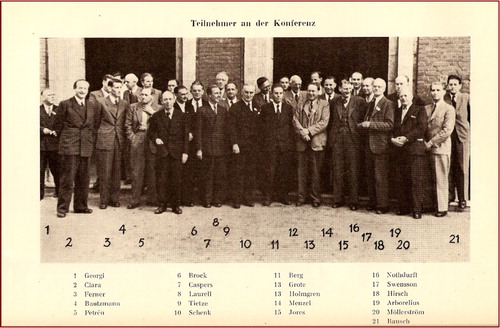
FIGURE 2 4th Conference of the International Society for Biologic Rhythm Research, Basel, 1953 (Menzel et al., Citation1955). The following illustrious chronobiologists can be identified in the photograph: F. Halberg, J. Aschoff, W. Menzel, A. Jores, H. Kalmus, and G. Hildebrandt.
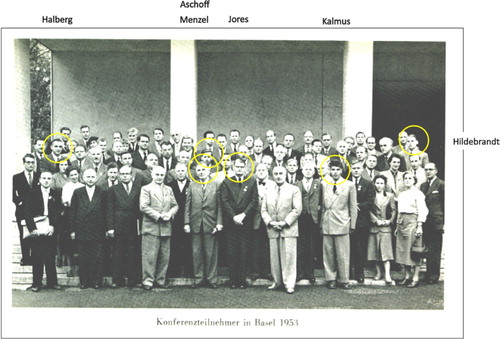
Several noted chronobiologists are shown in the two figures. Jürgen Aschoff (1913–1998) is considered one of the fathers of chronobiology. He was director of the Max-Planck-Intitute in Ehrlich-Andechs near Munich and conducted biological rhythm research both on animals and humans, including under free-running conditions in his bunker experiments. He coined the term zeitgeber and developed many concepts of great importance to the field. Franz Halberg (*1919) is another one of the founders of chronobiology. He established the Chronobiology Laboratories at the University of Minnesota and is credited with introducing the term circadian into the scientific language. The physician Arthur Jores (1901–1982) was a professor of medicine at the University of Hamburg. He made important contributions to the field of rhythms in kidney function, pain perception, and many other areas of medical chronobiology. Hans Kalmus (1906–1988), University College (London), was a biologist who studied the rhythmic behavior of bees, drosophila, and other animal species as well as genetic responses to the seasons of the year and hours of the day. Werner Menzel (1908–1998) was a physician in Hamburg who made a number of significant contributions to the field of clinical chronobiology. Gunther Hildebrandt (1924–1999) was a professor at the University of Giessen; his main scientific interest was the introduction of chronobiology into medicine. He researched the chronobiology of many topics, including balneology, pain perception, and lung and cardiac function. Although not shown in the photograph, the botanist Erwin Bünning (1906–1990) of the University of Tübingen also attended the 1955 conference. He is considered to be one of the founding fathers of chronobiology; he and Jürgen Aschoff are credited with the developing the early concept of the internal clock.
INTRODUCTION
Living organisms are continuously influenced by external stimuli, many of which exhibit cyclic patterns. Daily and seasonal environmental patterns of light (resulting from the regular rotation of the earth around its central axis), food availability, and temperature are predictable, and animals, including humans, possess the ability to anticipate these cyclic environmental events by periodic and predictable changes in internal conditions. These rhythmic patterns of anticipation have clear advantages and survival value. Indeed, rhythmicity is the most ubiquitous feature of nature. Rhythms are found from simple unicellular to complex multicellular organisms—in plants, animals, and man. The frequencies of human biological rhythms cover nearly every division of time: oscillations of one per second (e.g., in the electroencephalogram), one per several seconds (e.g., respiratory rhythm, heart rate), one within 24 h (e.g., circadian rhythms), up to one per year (e.g., circannual rhythms). All such types of rhythms were first observed and reported centuries ago.
General descriptions as well as detailed measurements of human biological rhtythms can be found in many ancient texts. One very famous report, Die Kunst das menschliche Leben zu verlängern (see ), was published more than 200 years ago by a teacher in pharmacology at the University of Jena—Christoph Wilhelm Hufeland, who was also the medical doctor of J.W. von Goethe (Hufeland, Citation1797). He wrote, “Due to the regular rotation of our planet there is a 24-hour period transmitted to all inhabitants on earth…and in all kinds of diseases this regular period can be found again, and this 24-hour period determines the wonderful timing of all our bodily functions. This period can be called the unit of the chronology of nature” (Hufeland, Citation1797, pp. 550–551).
FIGURE 3 Hufeland Die Kunst das menschliche Leben zu verlängern, Jena, akademische Buchhandlung, 1st ed., pp. 550–551 (Hufeland, Citation1797).
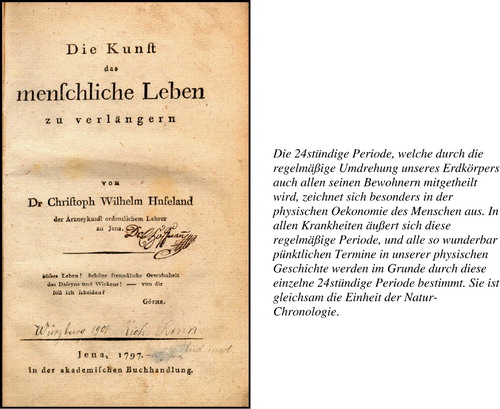
Another important early publication on the importance of medical chronobiology and biologic rhythm research in health and disease is the doctoral thesis of Julien-Joseph Virey, Éphémérides de la Vie Humaine, ou Recherches sur la révolution journalière, et la périodicité de ses phénomènes dans la santé et les maladies (see ), presented to the Medical Faculty of Paris in 1814 (Virey, Citation1814). He described not only rhythmic observations, including the differential benefit of the timed dosing of medications such as opium, but gave consideration to underlying mechanisms. Virey also referred to Thomas Sydenham (1624–1689), who is recognized as one of the founders of clinical medicine and epidemiology (Sydenham, Citation1697). Sydenham recommended administering the medication parégorique opiatique (p. 37) in the evening to optimize its effect in reducing intestinal pain. In order to explain his rhythmic observations, Virey (Citation1814, p. 33) suggested “une sorte d'horloge vivante, montée par la nature, entraînée par le mouvement rapide du soleil” (“a kind of living clock, made by nature, and entrained by the rapid movement of the sun”). Virey is also considered to be the first chronopharmacologist based on his observations and concepts as embodied by his statement: “Tout médicament d'ailleurs n'est pas également bien indiqué à toute heure” (“All medicines are not equally indicated effective given at different hours of the day”) (Virey, Citation1814, p. 37). A thorough description of Virey's achievements and contributions to chronobiology can be found in Reinberg et al. (Citation2001).
FIGURE 4 Thesis of Julien-Joseph Virey presented to the Medical Faculty of Paris in 1814 (Virey, Citation1814). Appreciation is acknowledged to A. Reinberg for providing the author a copy of this thesis.
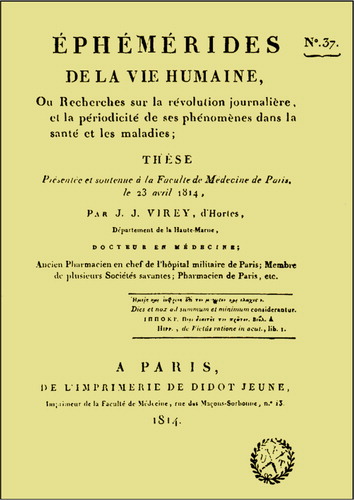
Eight years before Virey presented his thesis, the French physician J.A. Murat, of the Medical School of Montpellier (France), published his outstanding book De L'Influence de la Nuit sur les Maladies ou Traité des Maladies Nocturne (Murat, Citation1806). The most evident motivation for his observations is the constant and periodic movement of the earth around its axis, resulting in a period of about 24 h, and the elliptic rotation around the sun with a duration of 365 days, 5 h, and 49 min: “Le globe de la terre a deux mouvemens constant et périodiques. L'un diurne, par lequel it tourne autour de son axe, dont la période est de 24 heures, ce qui forme le jour, … ; l'autre annuel, et autour du soleil, se fait dans un orb elliptique durant l'espace de 365 jours, 5 heures, 49 minutes” (Murat, Citation1806, pp. 102, 124). Murat referred the work of Sanctorius, Medicus, Floyer, de Bordeu, Hellwig, and Zimmermann, who are also cited in this review. Murat described periodic phenomena in physiology and in health and disease: “La phénomène périodique le plus remarquable parmi les fonctions physiologiques, et qui coincide le mieux avec les succession constante du jour et de la nuit … c'est le retour alternatif du sommeil et de la veille. Cette fonction n'appartient pas aux phénomènes du périodisme physique, mais elle s'en rapproche, si la cause qui fait naitre ne réside point en nous:Il existe donc une cause, qui oblige le principe de vie de répéter les actes alternatifs de sommeil et de la veille” (Murat, Citation1806, p. 124). Furthermore, he summarized nearly all observations of that time made on nocturnal diseases. He was curious to learn the basic principle of life that repeats alternations, such as sleep and wakefulness: “Dans tous les temps l'homme a voulu pénétrer la raison des choses” (p. 102). Murat also was the first to show that the menstrual cycle, based on data collected between 1773–1775 (for more than two years) from one woman by a physician, is independent of the lunar cycle (see ). At the end of the 20th century—that is, at the time of women's liberation movement—this idea was very popular with the public. Obviously, the discovery of Murat was unknown.
FIGURE 5 Murat's book, De L'Influence de la Nuit sur les Maladies ou Traité des Maladies Nocturne, on periodic phenomena in health and disease. The table (p. 128) shows data on the monthly ocurrence of the menstrual cycle in relation to the cycle of the moon in one woman. Murat found no corrrelation between the two cyclic phenomena (Murat, Citation1806).
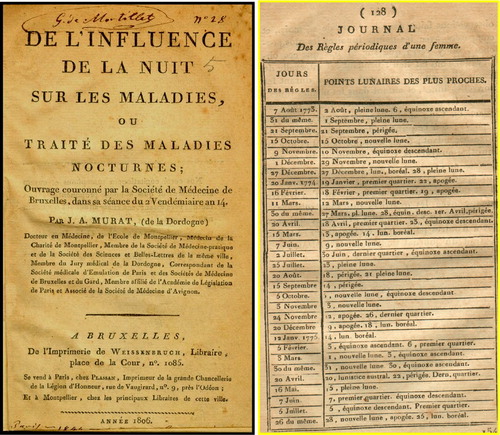
A great number of historical reports refer to observations of periodicities in specific diseases. The following sections review these observations, and at the end of each section, the impact of these early discoveries on modern medicine is briefly highlighted.
BRONCHIAL ASTHMA
Asthma is a chronic inflammatory disease of the airways characterized by hyperresponsivness to a great variety of substances and stimuli. Nighttime worsening of asthma has long been recognized—at least since the second century, based on the work of Soranus from Ephesus, who practiced medicine in Alexandria and later in Rome. The Roman physician Caelius Aurelianus in the fifth century was one of the first to report in a chapter of his book, De Morbis Acutis & Chronicis, on the daily variation in asthma attacks: “De Suspirio, sive Anhelitu, quem Graeci Asthma vocant – Gravat autem atque premit haec passio magis mulieribus viros, & juvenibus senes, atque pueros, & durioribus natura corporis teneriora, hyberno, atque nocte magis, quam die vel aestate” (“On the heavy breath and wheeze which is called asthma by the Greeks, this disease is a burden, and men suffer more than women, and the elderly more than the young … during winter and at night more than during the day or in spring”) (Aurelianus, Citation1722, p. 429). Caelius Aurelianus is considered by most historians to have been the greatest Greco-Roman physician after Galen. Caelius Aurelianus probably practiced and taught in Rome and is today ranked second only to the physician Celsus as a Latin medical writer. His most famous work, De Morbis Acutis et Chronicis (Concerning Acute and Chronic Diseases), constitutes a thorough exposition of the classical medical knowledge of the times and was regularly reprinted up to the 18th century (see ).
FIGURE 6 Caelius Aurelianus lived in the 5th century. His textbook, De Morbis Acutis et Chronicis, describes the nocturnal occurrence of asthma. Editio nova. Amsterdam, Wetsten (Aurelianus, Citation1722).
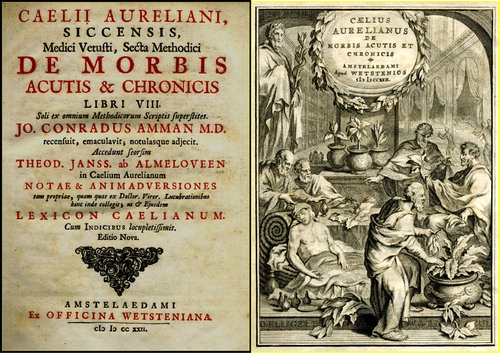
Additional early observations and discriptions of nocturnal asthma are known. In 1568, Wirsung (Citation1568) related in his Arzney Buch (Book on Drugs, see ) that the symptoms of asthma—a severe wheezing breath—occur between 2 h after midnight until the morning: “§9 Von schwerem keuchendem Athem: Jedoch etwas einleitung zu geben/seye diß der anfang. Wo dieser kurtzer unnd keuchender Athem/auß zeher Phlegmatischer materi/welche die Brüst erfület kommet/So hast du diß bey volgenden zeichen zu erkennen/daß sich eine schwere/truckende engin des Athmens erzeigt/unnd mehr umb die zeit/wann sich der Schleim bewegt/das ist zwo stund nach Mitternacht biß auff den Morgen” (Wirsung, Citation1568, pp. 201–202).
FIGURE 7 Front page of Wirsung's Arzney Buch (Wirsung, Citation1568), in which asthma symptoms are described as occurring at night.

In 1616, Castello Petro Vasco stated in his book chapter, Tractatus Tertius de Asthmate, that asthma is a predominantly nocturnal disease (“atqui Asthmatica dispositio nocturnis horis magis affligit”) that is more severe during winter and at night than during summer and daytime (“hyberno tempore, atque nocte magis quam die, vel Aestate”) (Vasco, Citation1616, pp. 253–254). He also used the term asthma noctu (nocturnal asthma) to characterize the asthmatic disposition that predominates during the night (see ).
FIGURE 8 Textbook of Castello Petro Vasco, Exercitationes Medicinales ad Omnes Thoracis Affectus, decem Tractatibus Absoluta. Raymon Colomerius (Raymundum Colomerium, Regis & Academiae Tolosanae), Toulouse (Vasco, Citation1616).
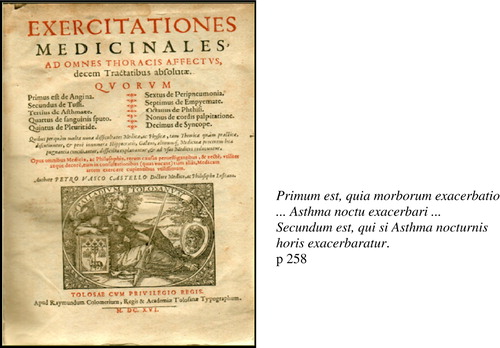
In the 18th century, the English physician Sir John Floyer (1639–1734), who suffered from asthma for about 30 yrs, remarked in his book, A Treatise of the Asthma (1698), “I have observed the fit always to happen after sleep in the night” (Floyer, Citation1698, Citation1761, p. 102). Floyer decribed his own symptoms in great detail, and how they were influenced by the environment and seasons and by treatment. He writes, “I cannot remember the first occasion of my asthma, but I have been told that it was a cold when I first went to school. As my asthma was not hereditary from my ancestors, so I thank God neither of my two sons are inclined to it, who are now past the age when it seized me” (p. 20). The first French edition of his book is shown in .
FIGURE 9 First French edition of Floyer's work on asthma, Traité de l'Asthme. PF Didot le jeune, Paris (Floyer, Citation1761).
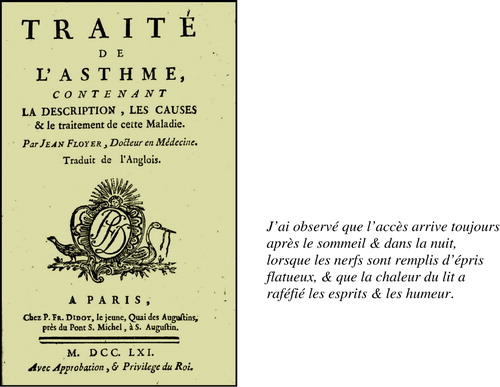
Coste (Citation1767) described in his book, Traité des Maladies du Poumon, the asthmatic attack as an obstruction of the small bronchi (“les petits extrémités des bronches resteront obstruées”) (see ). Interestingly, he also noted the inflammation of the bronchial membranes in asthma: “S'il est arrivé á la suite d'une légère inflammation de la membrane don't trachée artère & les bronches du Poumon” (Coste, Citation1767, p. 43). This observation was not fully appreciated until the end of the 20th century, as documented by the recommendation of national and international clinical disease guidelines that antiinflammatory medications, such as topical corticosteroids, be a primary means of managing bronchial asthma (Expert-Panel-Report, Citation2007).
FIGURE 10 Coste's Traité des Maladies du Poumon (Coste, Citation1767).
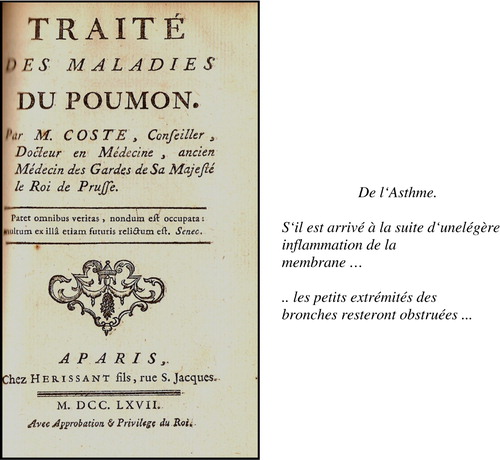
Later on, Armand Trousseau (1801–1867), who like Floyer also suffered from nocturnal asthma (“Ainsi pour moi, qui depuis lengtemps en suis affecté, mes attaques me prenaient autrefois vers trois heures du matin”) (Trousseau, Citation1868, p. 441) and allergic rhinitis, published his excellent observations in Clinique Médicale de l'Hotel-Dieu de Paris. Of course, Trousseau's insight preceded the discovery of allergy, allergens, and underlying immunological processes (Trousseau, Citation1868). Trousseau was a physician in the Hôtel-Dieu awarded the chair of therapy and pharmacology of the Paris Medical Faculty. Trousseau suspected his cab driver was stealing oats from his horses, which motivated him to go to the horse stable during the night to check the number of bags. Trousseau found that when he manipulated the bags of oats to feed the horses at night, the inhaled dust triggered an asthma attack (see ). He also conceived and described allergic rhinitis as asthma of the nose (“Le coryza, mais un coryza spéciale, peut être l'expression de la maladie et en constituer la seul manifestation”) (Trousseau, Citation1868, p. 440). Furthermore, he ordered inhalation of an anticholinergic compound (Datura stramonium) as a remedy for asthma (Trousseau, Citation1868, pp. 444, 468). It is of interest that anticholinergics still are used today to manage this medical condition (Expert-Panel-Report, Citation2007).
FIGURE 11 Armand Trousseau's book, Clinique Médicale de l'Hotel-Dieu de Paris. J.-B. Baillière et fils, Paris 1868, p. 447 (Trousseau, Citation1868).
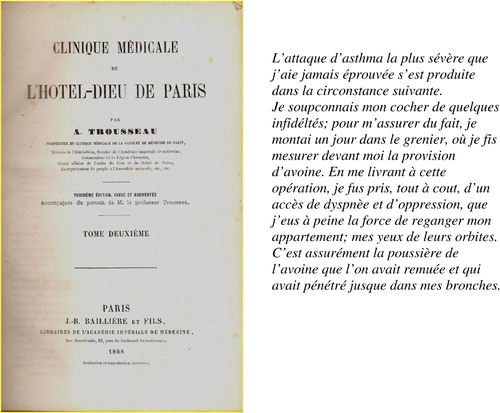
Finally, it should be mentioned the French physician, Murat, also recognized asthma to be an nighttime disorder, “nocturnal asthma” (Nocturne simple: est paticulière à l'asthma.) (Murat, Citation1806; pp. 72, 120).
The father of experimental pharmacology, Rudolf Buchheim (1820–1879) of the German Dorpat University (now Tartu, Estonia), recommended in his Textbook on Pharmacology, Lehrbuch der Arzneimittellehre, published in the middle of the 19th century, to use atropin extracts (Belladonnablätter) to treat periodic asthma: “frequently one is allowed to smoke leaves from Jimson weed or deadly nightschade…which seems to be of special value in periodic asthma”(CitationBuchheim, 1853–1856, p. 527; see ). Synthetic anticholinergics are nowadays also mediciations of choice in the treatment of asthma and COPD (chronic obstructic pulmonary disease) (Expert-Panel-Report, Citation2007).
FIGURE 12 Textbook on Pharmacology, Lehrbuch der Arzneimittellehre, of R. Buchheim, L. Voss, Leipzig (CitationBuchheim, 1853–1856).
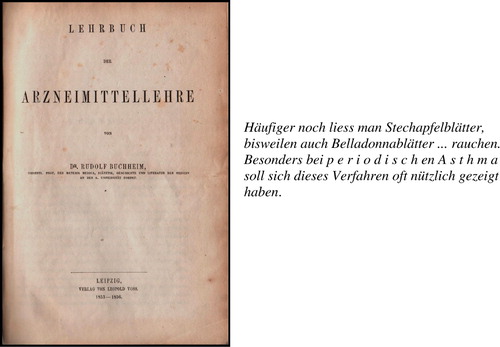
Impact on Modern Medicine
International (Expert Panel Report) staging of asthma according to rhythm in peak flow, definition of nocturnal asthma;
Measurement of lung functions during day and night; development of peak flow meters for patient self-monitoring of circadian rhythm in airways status;
Recommendation of evening dosing of certain asthma medications;
Recognition that allergic symptoms more severe at night and early morning hours;
Dosing of medications (antihistamines, etc.) for allergic rhinitis in the evening.
For further discussion of bronchial asthma, please see Expert-Panel-Report (Citation2007) and Smolensky et al. (Citation2007b).
RHYTHMS IN HEART RATE
Heart rate was one of the earliest physiological functions reported not to be constant throughout the 24 h. As early as the beginning of the 17th century, day-night variations in pulse rate (Sanctorius, Citation1631b; Struthius, Citation1602; Targiri, Citation1698) as well as rapid increase on awakening (Struthius, Citation1602) were described. In the 18th and 19th centuries and the beginning of the 20th century, general observations plus detailed data on daily variations in pulse rate and pulse quality were reported (Autenrieth, Citation1801; Barthez, Citation1806; Bordenave, Citation1787; Falconer, Citation1797; Hensen, Citation1900; Hill, Citation1898; Howell, Citation1897; Hufeland, Citation1797; Jellinek, Citation1900; Knox, Citation1815; Lemmer, 1989, Citation1991, 2001, Citation2004a, Citation2004b, 2005, 2007a; Reil, Citation1796; Weysse & Lutz, Citation1915; Wilhelm, Citation1806b; Zimmermann, Citation1793). Joseph Struthius (1510–1568), the physician of the Polish Emperor Sigismund, was apparently the first to correlate the different frequencies and qualities of the pulse through the annotation of music, as recorded in his book, Ars Sphygmica (see ). This idea was used again by Quantz (see below). Struthius also mentioned that variations in pulse rate can differ between men and women, sleep and activity, health and disease, and season (see ). Thus, Struthius is one of the first outstanding scientists who showed that pulse rate is regulated both by internal and external factors. Johann Struthius was also the first to note that the pulse rate can be influenced by aging (Struthius, Citation1602) (see ). Years later, data were presented by many others to verifiy this observation (Autenrieth, Citation1802; Bordenave, Citation1787; Falconer, Citation1797; Hufeland, Citation1797; Zimmermann, Citation1793).
FIGURE 13 First description of a correlation of pulse rate with annotation of music, with mention of the different causes of changes in pulse rate, including season, in Struthius' book, Ars Sphygmica (Struthius, Citation1602).
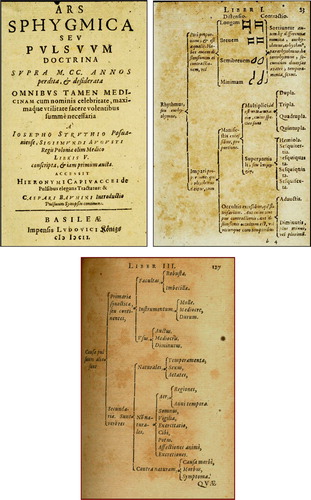
In 1767, the famous surgeon and urologist Le Cat (1700–1768) confirmed in his book, Traité des Sensations et Passions en Général et des Sens en Paticulier, that music has a great effect on the human soul: “Ce pouvoir qu'a la musique de remuer l'ame, & par elle toute la machine, la rend très-propre à la santé; et vous consévrez aisément cet effet, si vous avez compris la grande liaison qui est entre ces deux parties de l'homme” (Le Cat, Citation1767, p. 286).
Increase in pulse rate and blood pressure at the sight of the doctor, termed office or white-coat effect, is neither a new nor a recent observation. More than 300 years ago, Targiri reported in his book, Medicina Compendaria, that pulse can be modified by internal and external factors, such that even the presence of the doctor can increase the pulse of a patient: “Ante omnia in scrutanda pulsatione arteriae scientum est, hujusce motum varie accelerandi, minui, imo turbari posse a causis & circumstantiis externis; in quibus minimi momenti non est ipse adspectus & introitus medici, quo saepe aegri vel ad tristitiam vel ad hiliratetem diversimodo disponuntur, quod sane multam excitare in pulsu mutationem potest” (“First of all, one has to be experienced in studying the pulse, the movement of which can be many-fold increased, reduced, and disturbed due to internal and external reasons. Even the sight of the doctor and his entrance into the office is not of minor importance, since this can result in an increased movement of the pulse”) (Targiri, Citation1698, p. 662; see ).
FIGURE 14 Front pages of the books of Targiri (Targiri, Citation1698) and Hellwig (pseundonym: Kräutermann) (see Hellwig, 1738) describing the so-called office/white coat effect on patients when assessing heart rate and as also appreciated nowadays when assessing blood pressure (see Lemmer, Citation1995).
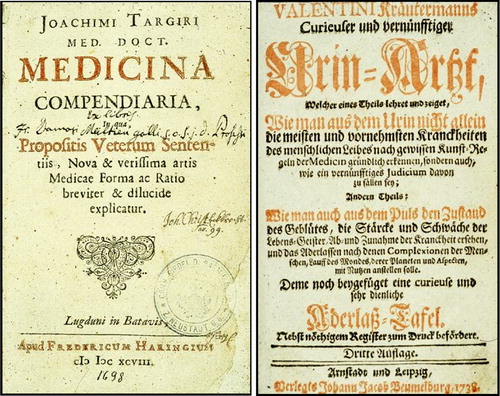
A similar observation was described by Hellwig (pseudonym: Valentin Kräutermann) in his book Curieuser und Vernünftiger Urin-Arzt: “Vor allen Dingen stehet aber zu wissen, daß der Puls sich mercklich verändern … könne, wozu nicht wenig Anlaß giebet die Ankunft des Medici, dannenhero der Medicus nicht alsobald beym Eintritt über den Patienten herfahren soll, und den Pulß fühlen, er muß sich erstlich eine Weile niedersetzen, und mit dem Patienten discutiren, und währenden Discurs einmal oder etliche die Ader fühlen” (“It is important to note that the pulse can vary greatly … a main reason is the advent of the doctor, when he enters the office, he has to sit down at the site of the patient, talk to him, and then he can feel the artery of the patient once or several times”) (Hellwig, 1738, p. 134; see ). This is also the basis for the recommendation found in today's medical guidelines for the office measurement of blood pressure to avert or minimize the risk of the so-called white-coat effect resulting in a diagnosis of (pseudo)hypertension. Théophile de Bordeu (1722–1776), a French physician in Montpellier (France), also described in Recherches sur le Pouls the symptoms of what he termed the “pulse of the doctor.” He wrote: “In order to estimate the quality of the pulse, it is neccessary to feel the pulse several times; it is an exception that the presence of the doctor does not lead occasionally to some changes which may elevate or increase it: the practitioners never forget to keep in mind the pulse which they call the ‘pulse of the doctor’” (de Bordeu, Citation1756, p. 471; see ).
FIGURE 15 Front page of the book of Bordeu, Recherches sur le Pouls, (de Bordeu, Citation1756) describing “pulse of the doctor” (i.e., office/white-coat effect) (see Lemmer, Citation1995).
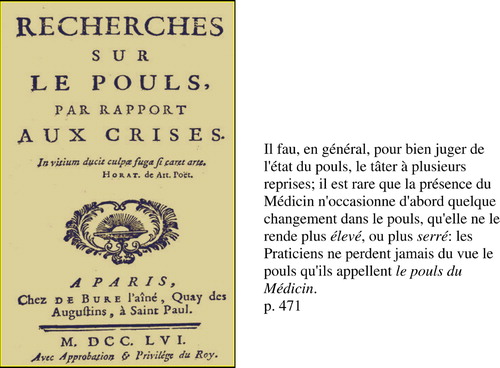
In those times, however, it was difficult to precisely measure the heart rate, as no watches built with minute hands were easily available. Sanctorius Sanctorius (1561–1636), a professor of physiology at the University of Padua, was aware of this problem. He invented a device—the first machine system in medical history—that he called the pulsilogium to measure the pulse (Sanctorius, Citation1631a, Citation1631b; see ): “In order to be able to commemorate quickly and excatly my knowledge on the pulse of a patient, I have invented the pulsemeter (pulsilogium), which is possible to measure exactly the beats of the arteries … and to compare them with the beats of earlier days …. With the help of the pulsemeter, we can monitor at what day and at which hour the pulse deviated in intensity and frequency from its natural state” (Sanctorius, Citation1631b, p. 289). By modifying the length of the pendulum of the pusilogium, the pulse rate of a patient could be kept for later comparisons.
FIGURE 16 Cover page of Methodi Vitandorum, description of the pulsilogium, a device invented by Sanctorius (Citation1631b) to measure pulse rate; detailed data are given in Sanctorius' book De Inventione Mediorum (Sanctorius, Citation1631a).
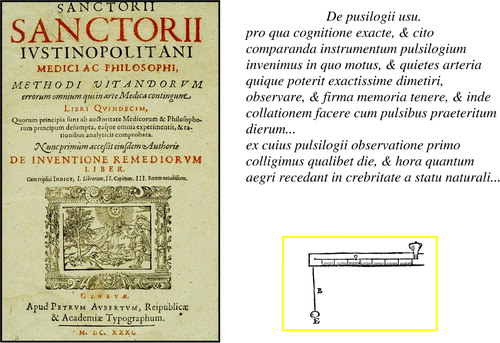
John Floyer (1649–1734) was also interested in measuring pulse rate. In 1710, he wrote: “I have for many years tried pulses by the minute in common watches and pendulum clocks and then used the sea-minute glass such as is employed to test the log” (The Physician's Pulse-Watch; or An Essay to Explain the Old Art of Feeling the Pulse and to Improve It by the Help of a Pulse-Watch [Floyer, 1707–1710]).
The pulse of a healthy subject as determined in the late afternoon was even proposed as an easily available metronome for use by musicians playing the flute (Quantz, Citation1752, Citation1906). Johann Joachim Quantz (1697–1773) was a famous composer of his time and the conductor and teacher of the flute to King Frederic II of Prussia; the flute concerts with the king in his castle Sansscoucci in Potsdam near Berlin were reknown: “Man wird sagen, daß der Puls des Morgens vor der Mahlzeit langsamer, als Nachmittags nach der Mahlzeit, und des Nachts noch geschwinder als Nachmittags schlage: …. Man nehme den Pulsschlag, wie er nach der Mittagsmahlzeit bis abends, und zwar wie er bey einem lustigen und aufgeräumten … Menschen … geht, zum Grunde: so wird man den rechten [Takt] getroffen haben.” (“What I found to be an appropriate time-giver for the tempo…is the pulse at the hand of a healthy man …. One should take the pulse of a merry and good tempered man…as it is after lunch until evening and the tempo will be fine”(Quantz, Citation1752, p. 206; see ). The metronome itself was not invented until 1816 by Johann Nepomuk Mälzel (1772–1838); the idea was proposed by the composer Ludwig van Beethoven, who desired a more precise device to define the tempo of music.
FIGURE 17 From Johann Joachim Quantz's, Versuch einer Anweisung die Flöte traversière zu spielen, first published in 1752; shown on the right is also a reprint of the original in 1906 (Quantz Citation1752, Citation1906).
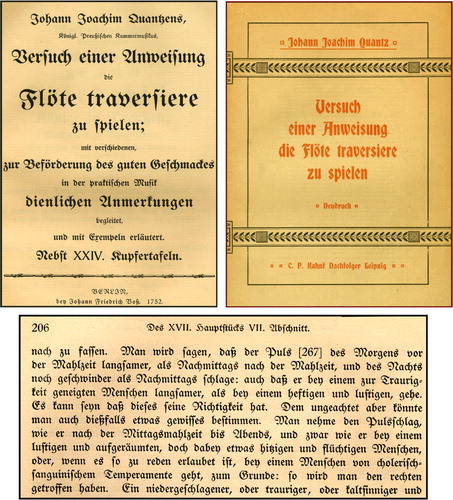
In subsequent years, many reports were published on the rhythm in heart rate, both in health and disease. Wilhelm Falconer (1744–1824), a British physician at the General Hospital in Bath and member of the Royal Society of Sciences of Great Britain, wrote: “Es ist eine bekannte Sache, daß der Puls selbst im gesunden Zustand sich bedeutend in den verschiedenen Zeiten des Tages verändert” (“It is well known that in in good health, the pulse varies at different times of the day”) (Falconer, Citation1797, German ed., p. 24; see ).)
FIGURE 18 Falconer's Beobachtungen über den Puls, with a table showing pulse rate data of two persons (A, B) in the morning and afternoon. First German edition, J S Heinsius, Leipzig, pp. 27–28 (Falconer, Citation1797).
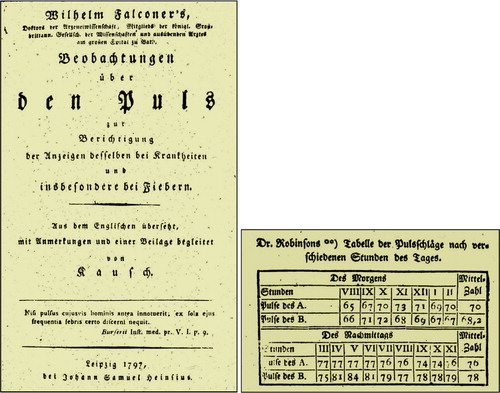
In 1776, Carlo Gandini also gave very precise recommendations (Gandini, Citation1776) of how to measure the pulse correctly by placing the fingers on the artery (see ).
FIGURE 19 Gandini's Gli Elementi dell' Arte Sfigmica… G. Castello, Napoli (Gandini, Citation1776).
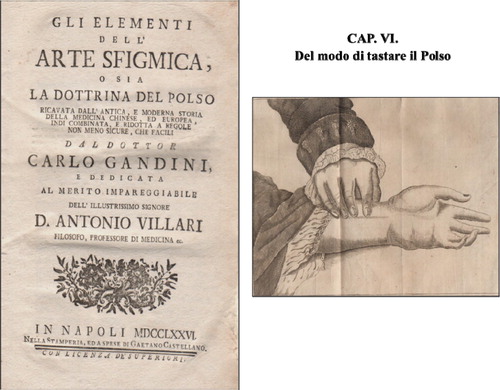
M. Bordenave, a French surgeon and Royal Professor at the Royal Academy of Sciences, described that the pulse varied between waking hours and during sleep (Bordenave, Citation1787; see ). Similarly, the Swiss physician Johann Georg Zimmermann (1728–1795), who later in his life became the physician of many royals (Hannover, Prussia, Russia), mentioned in his book Von der Erfahrung in der Arzneykunst (Zimmermann, Citation1793) that the number of pulses in man was dependent on the time of day, temper, age, and sex (see ). Furthermore, he noticed that the pulse rate raises during fever, and recommended that the pulse is best measured by use of the second-hand of the clock (see ).
FIGURE 20 Bordenave's Essai sur la Physiologie, describing variations in pulse during wakeness and sleep (Bordenave, Citation1787).
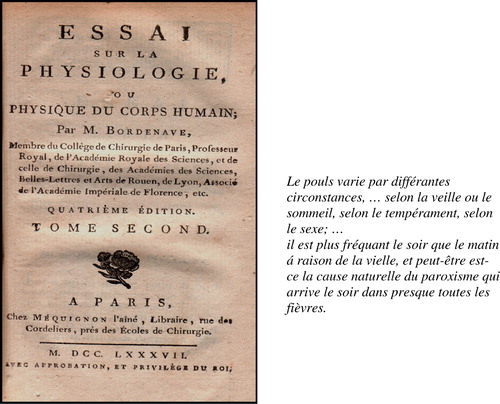
FIGURE 21 Cover page of Zimmermann's book, Von der Erfahrung der Arzneykunst, von J.T. Edlen von Trattnern, Agram (Zimmermann, Citation1793).

Obviously, the day-night difference in pulse rate was one of the most prominent observations in medicine of those days. A professor at the University of Halle and subsequently Ordinarius at the Charité in Berlin, Johann Christian Reil (1759–1813)—who was also a physician to J.W. von Goethe—mentioned, “The pulse goes up when evening is coming; this is not a direct effect of some stimuli but due to an increase in sensitivity from morning to night.” (Reil, Citation1796, p. 134; see ). The rhythm in heart rate was already presented in 1801 in a textbook on physiology. Johann Heinrich Ferdinand von Autenrieth (1772–1835), a teacher of anatomy, physiology, and pharmacology at the University of Tübingen, Germany, presented exact data on the pulse rate in relation to time of day (Autenrieth, Citation1801, p. 209): “Nun aber geschehen in einer Minute bey einem erwachsenen Menschen des Morgens 65–70, des Abends 75–80 Pulsschläge” (“In an adult the pulse is about 65–70 in the morning, in the evening 75–80 beats per minute”) (see ). Moreover, Virey wrote in his thesis that the heart rate is lowest 2–3 h after midnight: “vers deux á trois heures après minuit, le pouls se relève considérablement” (Virey, Citation1814, p. 28).
FIGURE 22 Reil's Von der Lebenskraft, Archiv für die Physiologie, Gurtsche Buchhandlung, Halle (Reil, Citation1796).
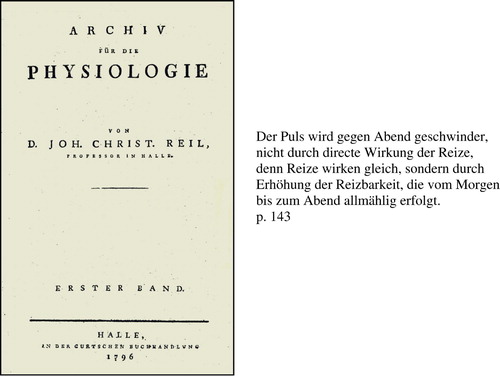
FIGURE 23 Cover page of Autenrieth's Handbuch der empirischen menschlichen Physiologie, Part 1. Tübingen, JF Heerbrandt, 1801 (Autenrieth, Citation1801, pp. 209, 277, 343).
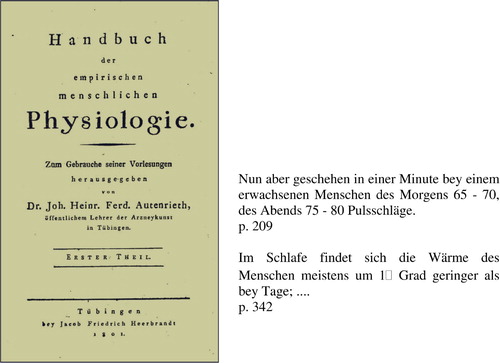
Interestingly, Gottlieb Tobias Wilhelm (1758–1811), a protestant clergyman and member of the Association of Doctors and Natural Scientists of Berlin and Halle, wrote in his book Unterhaltungen über den Menschen that pulse rate is also dependent on the frequency of breathing, differing between inhalation and exhalation (Wilhelm, Citation1806a; see ). Furthermore, daily variations in vasodilatation were reported by Paul-Joseph Barthez (Citation1806). Barthez (1734–1806), a physician and French encyplopedist who was a professor at the University of Montpellier (France), became the physician to the French King (Médecin Consultant du Roi), and in 1801 he was named the physician of the First Counsul (Médecin du Premier Consul). In is book Nouveaux Éléments de la Science de L'Homme, he mentioned more pronounced dilation of the small vessels a night: “La pléthora relative que je dis que le sommeil produit dans les derniers vaisseaux, est sans dout plus considerable dans les veines que dans les artères”(“The relative dilatation which I mentioned to occur during sleep in the small vessels is more pronounced in the veins than in the arteries”) (Barthez, Citation1806, p. 241; see ).
FIGURE 24 Cover page of Wilhelm's Unterhaltungen über den Menschen, Martin Engelbrecht'sche Kunsthandlung, Augsburg (Wilhelm, Citation1806a).
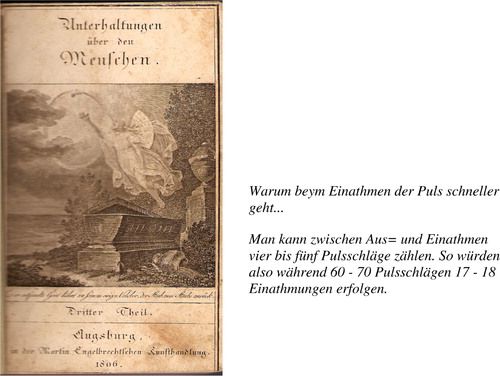
FIGURE 25 Barthez's Nouveaux Éléments de la Science de L'Homme. Second Édition, Paris, Goujon et Brunot (Barthez, Citation1806).
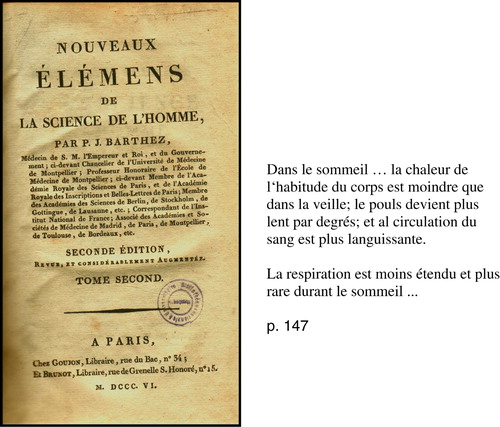
Impact on Modern Medicine
Development of devices for the continous monitoring of heart rate (e.g., Holter-ECG)
Inclusion of heart rate frequency spectrum in diagnostic procedures
Nightly dilatation of blood vessels documented
RHYTHM IN BLOOD PRESSURE
The English physiologist, chemist, and inventor Stephan Hales (1677–1761) was the first to directly study blood pressure in living animals (Hales, Citation1733, Citation1748c, Citation1780). Hales is best known for his Statical Essays. The first volume, Vegetable Staticks (Hales, Citation1727, Citation1748a, Citation1779), contains an account of numerous plant physiology experiments (i.e., water loss from plants by evaporation, rate of growth of shoots and leaves, variations in root-force at different times of the day, etc.). The second volume (Hales, Citation1733, Citation1748b, Citation1748c, Citation1780) of Haemostaticks, containing experiments on the “force of the blood,” its rate of flow, capacity of the different vessels, etc., in various animals qualifies him to be regarded as one of the originators of experimental physiology (see ). His book provided the first quantitative estimates of blood pressure. A glass tube inserted directly into the carotid artery of a horse permitted him to directly measure arterial pressure (i.e., as the height attained by the level of the column of blood). Hales was actually the inventor of the sphygmomanometer. This epochal work, so important to therapeutics ever since, was the most important step in the knowledge of circulation between Malpighi and Poiseuille.
FIGURE 26 Stephan Hales' famous book, Haemostaticks, the German edition form 1748. (Hales, Citation1748b) Right: A contemparatory picture showing Hale's experiment of determining the blood pressure in a living horse.
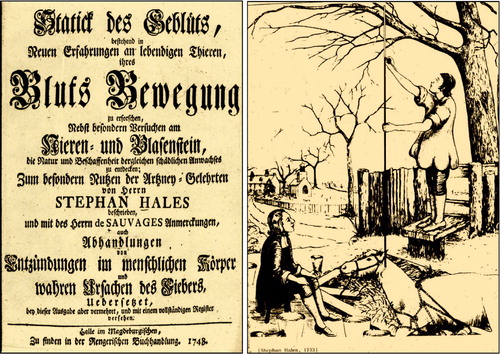
With the advent of plethysmographic devices (e.g., Riva-Rocci, Citation1896; von Basch, Citation1881; Zadek, Citation1881), it was also observed that blood pressure in healthy and diseased persons may not be constant throughout 24 h (see ). However, it was Zadek (Citation1881) who first presented detailed data on daily variations (Tagesschwankungen) in blood pressure, with an increase in the afternoon and a drop at night. Even different types of hypertension were described at the beginning of the 20th century based on their different 24 h blood pressure profiles (Katsch & Pansdorf, Citation1922; Müller, Citation1921a, Citation1921b).
FIGURE 27 Blood pressure monitoring during sleep at night by use of a long stethoscope (Katsch & Pansdorf, Citation1922).
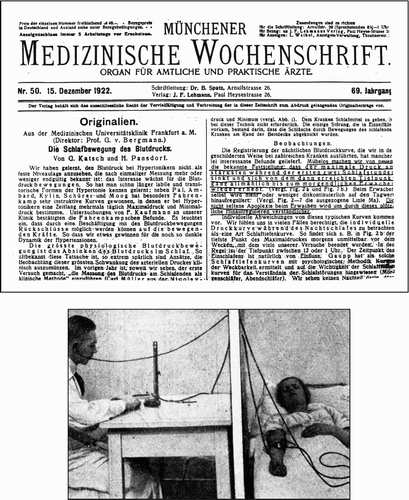
The English physician, James Hope (1801–1841), a member of the Royal Society of the Sciences in London, reported in his book Von den Krankheiten des Herzens und der großsen Gefäßse many situations in detail in which the rhythm of heart rate was modified by various diseases (Hope, Citation1833; see ). In addition, he described the symptoms of angina pectoris quite clearly: “… so beginnt sie mit einem Gefühle von Schmerz und Zusammenschnürung in der Präcordialgegend, verbunden mit einer mehr oder minder schmerzhaften Taubheit in dem linken Arme.…” (“It starts with a sensation of pain and constriction in the precordial area, in conjunction with a more or less painful deafness in the left arm”) (p. 392).
FIGURE 28 James Hope's Von den Krankheiten des Herzens und der grossen Gefässe. German edition, Berlin, Verlag Theodor Christian Friedrich Enslin (Hope, Citation1833).
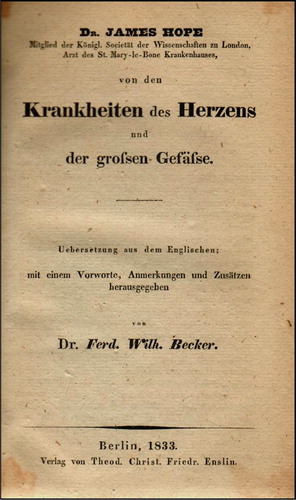
Impact on Modern Medicine
Development of ambulatory blood pressure monitoring devices (ABPM)
24 h blood pressure profile of diagnostic value for differentiating subtype forms of hypertension (primary, secondary hypertension), related to blood pressure values at night (dippers, non-dippers, super-dippers, risers)
Disturbed circadian blood pressure profiles as risk factors in severe hypertension, kidney disease, endocrine diseases, diabetes mellitus, sleep aponea, etc.
Office (white-coat) hypertension defined as a distinct (pre)form of hypertension
For further discussions of rhythms in blood pressure, please see Hermida et al. (Citation2007), Lemmer (Citation2006), and Middeke and Lemmer (Citation1996).
RHYTHM IN BODY TEMPERATURE, BODY WEIGHT, AND PERSPIRATION
In 1782, the German physician Christoph Friedrich Elsner (1749–1820), a professor of medicine at the University of Königsberg, Germany, published a book on the “daily lapse of fever” (see ): “The daily lapse of fever attack … is due to a general law in nature responsible for a daily revolution in the human body such as the regular occurrence of sleep, of wakeness, of hunger, and evacuations as well as in the evening pulse. This revolution … results in more or less variations in all kinds of fever during the day. One could name these changes the daily lapse of fever”(Elsner, Citation1782, p. 36).
FIGURE 29 Elsner's Beyträge zur Fieber = Lehre, Wagner und Denzel, Königsberg (Elsner, Citation1782).
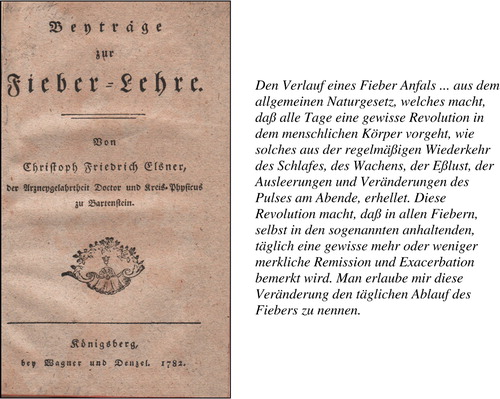
The great physiologist Sanctorius Sanctorius (1561–1636) was a professor at Padua from 1611 to 1624 where he performed experiments, including self-experiments involving body temperature, respiration, and weight. On a daily basis for a period of 30 yrs (“triginta annorum experimentis ad perfectionem deduxi”), Sanctorius weighed himself (see ), everything he ate and drank, plus his urine and feces. He compared the weight of what he had eaten to that of his waste products, the latter being considerably smaller. He developed the theory of insensible perspiration in an attempt to account for this difference. The “weighing chair” (“sella”), which he constructed and employed during these experiments (“ex usus istius sella”) is famous. He calculated the water loss due to sweating (“perspiration sensibilis”) and evaporation (“perspiration insensibilis”) during sleep, wakening, exercise, and rest (Sanctorius Citation1664, Citation1753; see ). In his aphorisms, Sanctorius Sanctorius reported sleep increases evaporation from the skin and even gave details on the extent of the weight loss of perspiration: “… ut septem horis quinquaginta unciae cocti perspirabilis … exhalent” (“50 ounces in 7 hours”) (Sanctorius, Citation1664, p. 2, 1753).
FIGURE 30 The weighing chair (sella sedento) of Sanctorius Sanctorius shown in his book, De Statica Medicina, with which he determined the perspiration insensibilis and performed around-the-clock experiments on himself for 30 yrs (Sanctorius, Citation1664).
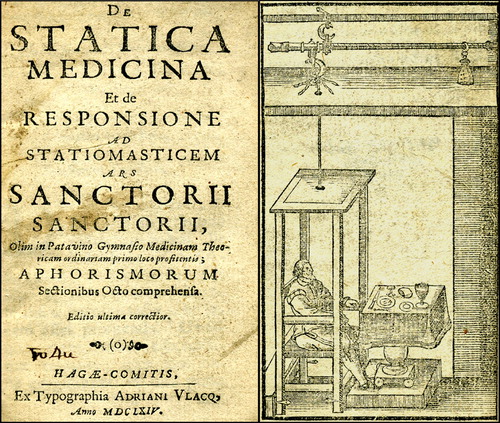
FIGURE 31 Sanctorius Sanctorius' De Statica Medicina Aphorismorum, in which he calcuated the water loss due to perspiration during sleep (Sanctorius, Citation1753).
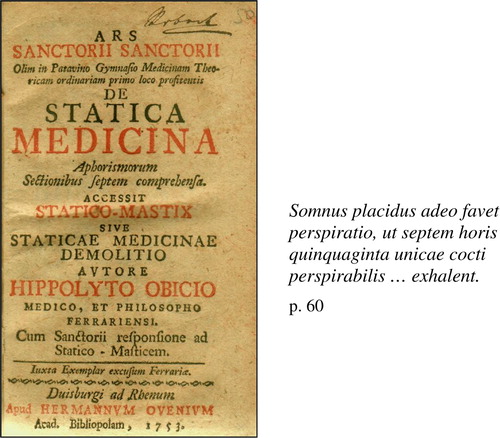
A daily rhythm in body temperature of man was reported by J. Davy in 1845 (Davy Citation1845). In 1868, Carl Reinhold August Wunderlich (1815–1877), a professor at the Medical Clinic Tuebingen and subsequent professor in Leipzig, reported detailed observations on the 24 h rhythm in body temperature. Interestingly, he also presented much data and numerous figures on the day-night variation in body temperature in various disease states (Wunderlich, Citation1868). He observed that these day-night variations in body temperature even persisted—though at a different level—during disease (e.g., typhus; see ). Barthez (Citation1806, p. 147) also reported on the day-night variation in body temperature: “Dans le sommeil … la chaleur de l'habitude du corps est moindre que dans la veille” (“During sleep the body temperature … is less than during wakening”) (see ).
FIGURE 32 Wunderlich's Verhalten der Eigenwärme in Krankheiten, O. Wigand, Leipzig (Wunderlich, Citation1868).
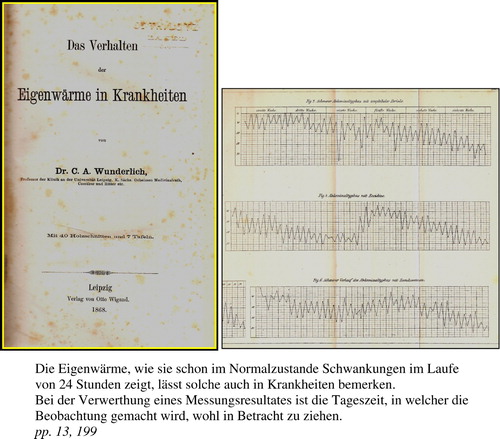
ANGINA PECTORIS
The British physician William Heberden is credited with the first description of angina pectoris: “There is a disorder of the breast, marked with strong and peculiar symptoms, considerable for the kind of danger belonging to it, and not extremely rare, of which I do not recollect any mention among medical authors. The seat of it, and sense of strangling and anxiety with which it is attended, may make it not improperly be called angina pectoris”(Heberden, Citation1772). A couple of decades later, in 1793, the Swiss physician Zimmermann (1728–1795) mentioned in his book On our Knowledge in Medicine (see ) that the symptoms of angina pectoris (“Engbrüstigkeit”) persist during the nighttime hours: “…wie in der Engbrüstigkeit, die … wenigstens bey der Nacht immer gleich ist” (Zimmermann, Citation1793).
Friedrich Casimir Medicus (1736–1808), a physician in Mannheim, Germany, published a wonderful book Geschichte periodischer Krankheiten (see ), in which he presented many examples of the periodic occurrence of disease onset (Medicus, Citation1764, p. 43). In , the morning onset of angina pectoris is described in a patient.
FIGURE 33 Medicus's Geschichte periodischer Krankheiten, first book, M. Macklot, Carlsruhe (Medicus, Citation1764).

In 1810, the German botanist and physician Kurt Sprengel (1766–1833) was the first to publish in his Handbuch der Pathologie that a certain kind of angina pectoris, so-called Brustbräune, has a typical nocturnal onset: “…during night, after the first calm sleep, the first attack is observed during night and consequent attacks occur in the morning” (Sprengel, Citation1810, pp. 135, 136, 230, 231; see ).
FIGURE 34 Sprengel's Handbuch der Pathologie. Leipzig, Kühnsche Buchhandlung, p. 135/230 (Sprengel, Citation1810, pp. 135, 136, 230, 231).
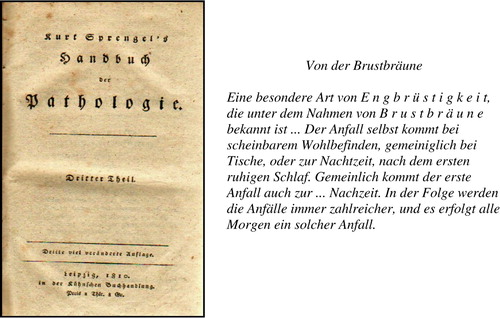
An Italian professor of medicine at the University of Bologna, Antonio Guiseppe Testa (1756–1814), described in 1815 the symptoms of angina attacks that occur during the nighttime hours: “… drückender Schmerz, Anfälle von Ohnmachten und Erstickungsgefahr … vor allem zur Nachtzeit” (“…deep pain, episodes of fainting and danger of asphyxia… mainly during the night).” He also stated in his text that recent observations of physicians clearly show angina attacks occur in the early morning hours: “Kapitel XII Von den Kennzeichen der Brustbräune: Auch die frühen Morgenstunden sind dazu sehr geeignet” (Testa, Citation1815; see ). It is important to note that early in the 19th century, it was not possible to differentiate between stable angina pectoris (pain and ST-segment depression in the ECG during the daytime) and vasospastic Prinzmetal angina (symptoms of pain and ECG abnormalities at night) (see Lemmer, Citation2006, Citation2007b).
FIGURE 35 First and only edition in German of Testa's book, Delle Malattie del Cuore, Loro Cagioni, Specie, Segni e Cura (Testa, Citation1815).
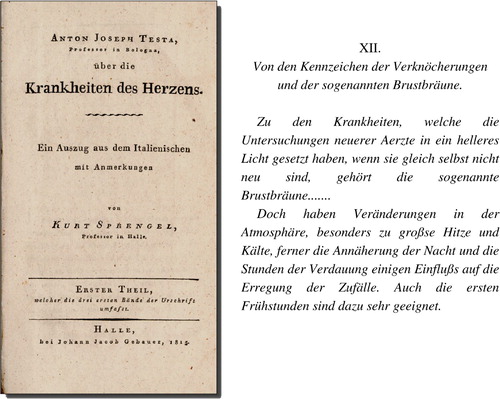
Impact on Modern Medicine
Circadian profiles of cardiovascular events (myocardial infarction, sudden cardic death, stroke, angina pectoris) well established
Diurnal variation in drug effectiveness in various types of angina
For further discussions of angina pectoris, please see Gallerani et al. (Citation2007), Lee et al. (Citation2008), Leibowitz et al. (Citation2007), Lemmer (Citation2006), Portaluppi and Lemmer (Citation2007), and Smolensky et al. (Citation2007a).
PSYCHIATRIC DISORDERS
In 1764, Medicus first described the symptom of winter depression: “Each year Dr. Helwig noticed during the month of December that depression reappeared in a patient” (see ).
FIGURE 36 Observation of winter depression by Medicus in Geschichte periodischer Krankheiten, M. Macklot, Carlsruhe (Medicus, Citation1764).
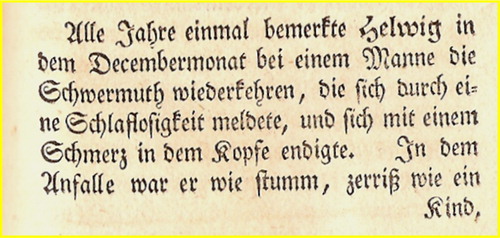
Sleep disturbancies in melancholia, however, had been earlier described by Geiger (1606–1671), a personal physician to the Bavarian Elector Maximilian in Munich: “On the signs of hypochondric mood both in diagnostics and pathognomonics: First of all being awake after midnight is not pleasant … Even if the patient sleeps well from supper to midnight there is a threat to be awake for hours … Others might not sleep sufficiently at all”(Geiger, Citation1652, p. 82; see ). In a similar manner, sleep disturbances in depression (melancholy) were described by Sprengel (see ). Sprengel also described that depression (melancholia) has a typical daily pattern, with “Der Melancholiker schläft nie ganz ruhig: er fährt sehr oft aus dem Schlafe auf: … und fühlt sich des Morgens mehrentheils müder als am Abend” (“increased tiredness in the morning hours than in the evening.” (Sprengel, Citation1810, p. 309; see ).
FIGURE 37 Front page of Malachias Geiger's book on depression, Microcosmus Hypochondriacus Sive de Melancholia … (Geiger, Citation1652). Below the title cylinder, the melancholic patient is lying in his bed; to his right the physician is presenting him a medicine; to his left the devil is blowing sounds of hypochondric hallucinations in his ear. At the lower left, the black hellebore flower (containing toxic saponines and the narcotic poison helleborine) is shown as a remedy for depression (the description of the copperplate print is given in Geiger's book).
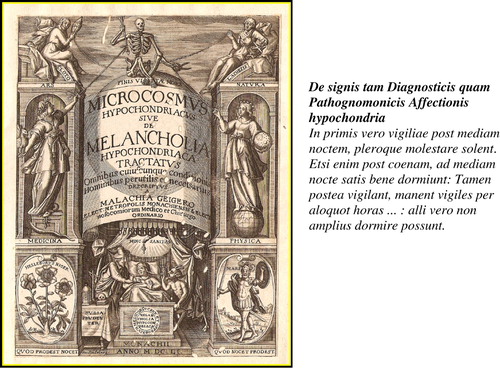
FIGURE 38 Sleep disturbance in a depressed patient. Sprengel Handbuch der Pathologie. Leipzig, Kühnsche Buchhandlung, p. 309 (Sprengel, Citation1810, pp. 135,136, 230, 231).
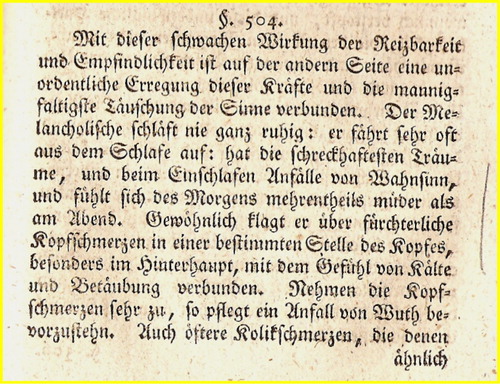
In 1946, Helmut Marx (1901–1945), a physician at the Universities of Heidelberg and Berlin, first described the effects of lack of light on physiological functions in soldiers living at the polar circle, an observation that is now recognized as a characteristic cause of winter depression: “The changes observed cannot be explained by a lack of light. The changes in the rhythm of light exposure might be of greater importance”(Marx, Citation1946; see ).
FIGURE 39 Marx's Zur Klinik des Hypophysenzwischenhirnsystems. 2. Mittelung Hypophysäre Insuffizienz (Marx, Citation1946).

Impact on Modern Medicine
Sleep disturbances regarded as (early) signs of depression
Daily rhythm of symptoms in depression accepted
Definition of winter depression included in the Diagnostic Statistic Manual of Psychiatric Diseases (DSM IV)
Therapeutic value of (early morning) bright light in winter depression
For further discussions of psychiatric disorders, please see Lewy et al. (Citation2006) and Wirz-Justice (Citation2008).
METABOLIC DISORDERS
Many early reports address the 24 h variation in the symptoms of gout. In 1697, Sydenham (1624–1689) described the symptoms of gout as being more severe in the evening with easing during the early morning hours (see ): “A Treatise of the Gout and Dropsie. There are thousand fruitful endeavours to ease the pain, … yet there is no ease to be had, till two or three a Clock in the Morning at which time the Sick has suddenly ease … ; … yet the pain always returns in the Evening, and is not so great in the morning …” (Sydenham, Citation1697, p. 215). He also differentiated between rheumatism and gout (Sydenham, Citation1697). Similar observations were reported by Caelius Aurelianus when he described that the joints are affected by arthritis and the feet by gout (podagra): “… altera cummuniter ab articulis omnibus, altera specialiter a pedus. … Nam podagra pedum tantummodo doler est. Arthritis vero etiam cunctorum articulorum, sive multorum”(Aurelianus, Citation1722, p. 557).
FIGURE 40 The Whole Works of the Excellent Practical Physician Dr. Thomas Sydenham (Sydenham, Citation1697).
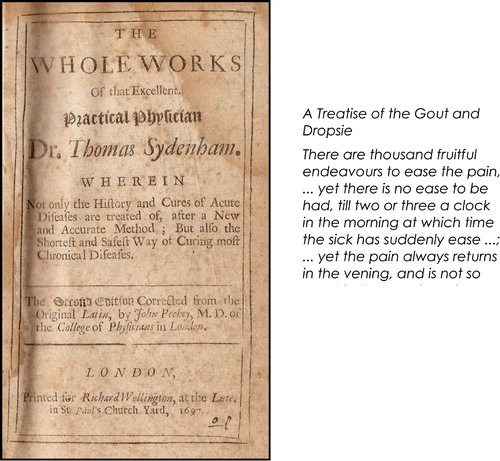
Other accounts of gout were published later. Coste (Citation1768) described gout as a disease of the rich people and that the symptoms peak in the evening (see ). Sprengel also described the 24 h variation in the symptoms of gout in 1810 (Sprengel, Citation1810, p. 125) and mentioned the pain in the peripheral joints of the feet and toes mainly occurs in the night (see ). Finally, the nocturnal occurrence of gout was mentioned by Murat in his book (Murat, Citation1806).
FIGURE 41 Daily variation in the symptoms of gout as described by Coste in Traité-Pratique de La Goutte (Coste, Citation1768).
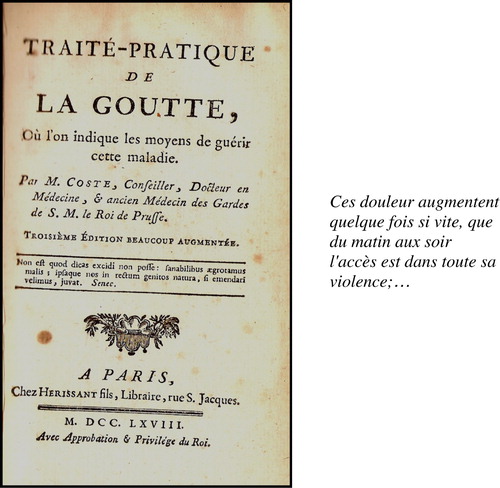
FIGURE 42 Daily pattern in the symptoms of gout described in Sprengel's Handbuch der Pathologie, second part, Schäfersche Buchhandlung, Leipzig (Sprengel, Citation1810, p. 125).
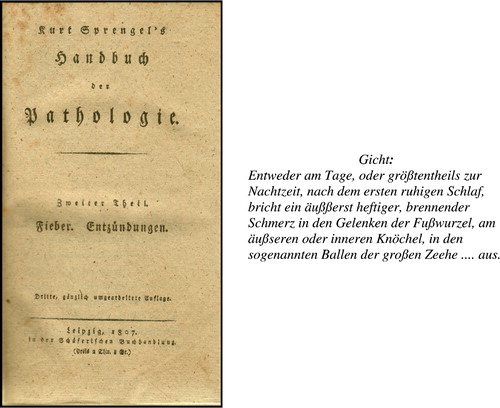
As previously mentioned, Sydenham also described the symptoms of rheumatism in detail (Sydenham, Citation1697, p. 453) in Chapter V—of a Rheumatism: “… It begins with shivering and shaking, and presently heat, restlesness, and thirst; and other symptoms follow which accompany a Fever. … The patient is troubled with a violent Pain, soemtimes in this, sometimes in that Joint, in the Wrists and Shoulders, but most commonly in the knee.”
In addition, Sprengel in 1807 described a time-of-day dependency in the symptoms of rheumatic fever (see ), with main symptoms occurring most prominently in the evening (Sprengel, Citation1807); however, he did not mention whether the symptoms of rheumatoid arthritis vary with time of day.
FIGURE 43 Daily pattern in the symptoms of rheumatic fever as described by Sprengel (Citation1807).

Impact on Modern Medicine
Morning pain and stiffness of joints are considered pathognomonic for Rheumatoid Arthritis
Circadian rhythms in cytokines established in rheumatoid arthritis
Evening dosing of non-steroidal antirheumatic drugs recommended
Recognition gout attacks occur at night
BIRTH AND DEATH
Alain Reinberg (Citation1998) previously reviewed the ancient tale of Nyx, the Greek goddess of the night. Nyx, a daughter of Zeus, is usually presented while breastfeeding her two twins, Hypnos (translation: sleep) and Thanatos (translation: death). Thanatos is presented with open eyes and Hypnos with closed eyes. This means that some 2400 years ago, our Greek ancestors had observed and believed in a kind of phase relationship between sleep and death during the night hours. This phase relation between sleep and death is the basis of observations made centuries later through recordings and epidemiological studies on the time of death. Beginning in the 17th century, it was common practice to record the date and clock times of births and deaths in parishes and some city registries. Some of these registries can still be located; however, much of this interesting information unfortunately has been lost because of the destruction of books and public records during wars in Europe, mainly during the 30 Years' War (1618–1648).
Both the beginng and end of life do not occur at random times during the 24 h of the day or the month and season of the year. In 1972, Smolensky et al. published a detailed review on daily and seasonal patterns in birth and death by reanalyzing previously reported data and summarizing them on a population basis (Smolensky et al., Citation1972). However, credit is due to much earlier investigators for their observations and reports of such temporal patterns. Virey's thesis in 1814 included a table on the time of day of deaths occurring over a 13-month span in Paris (May 1807 to May 1808). The peak number of deaths was in the late night/early morning hours (Virey, Citation1814, p. 31). This result corresponds to the findings of Smolensky et al. (Citation1972). shows the houly totals based on Virey's data along with the best fitting composite cosine curve approximation to his time series data. Table curve SPSS and cosinor time series analytical programs revealed a statistically significant 24 h variation, with the absolute peak revealed at 6 a.m. (Reinberg et al., Citation2001).
FIGURE 44 Virey's data (repeated plotted across two consecutive 24 h spans) on the time of day of deaths (Virey Thèse, Université de Paris, 1814). The absolute peak is found around 6 o'clock. Data were recalculated and analyzed by the author using Chronos-Fit (Zuther & Lemmer, 2004).

Detailed tables on the time of death from different causes, as well as birth, were also published by Johann Ludwig Casper (1796–1864) for the city of Berlin, Germany. Casper was a Professor at the University of Berlin and Royal Physician Councillor. In his book, Denkwürdigkeiten zur medicinischen Statistik und Staatsarzneikunde, he included 18th and 19th century data that he obtained from various sources. He also gathered his own data on thousands of patients in Berlin from 1833–1839 regarding the influence of time-of-day and seasonal variations (Casper, Citation1846). In addition, he presented data on seasonal variation in humidity. His book, containing numerous tables with detailed data, can be regarded as one of the first epidemiological treatises (see ). Casper's huge amount of data on mortality enabled him to conclude that a greater number of people die than expected during the early morning hours and that a lesser number than expected die during the hours before midnight: “Das Maximum der Sterblichkeit fällt auf die Vormittags-, das Minimum auf die Vormitternachtsstunden” (Casper, Citation1846, pp. 230ff). The data shown in the table of correspond to the findings of Smolensky et al. (Citation1972). From his data on birth, Casper concluded that “In den Stunden von 9 Uhr Abends bis 6 Uhr Morgens fallen die meisten, in die von 6 Uhr Morgens bis 9 Uhr Abends die wenigsten Geburten” (“In the hours from 9 o'clock in the evening until 6 o'clock in the morning most births are given, whereas from 6 o'clock in the morning until 9 o'clock in the evening less births are given”) (Casper, Citation1846, pp. 226 ff.; see ). Casper's book is highly exciting and a valuable source of information, and the detailed tabular data await further time series analyses!
FIGURE 45 Cover page of Casper's book, Denkwürdigkeiten zur medicinischen Statistik und Staatsarzneikunde, Publ. Duncker & Humblot, Berlin (Casper, Citation1846).
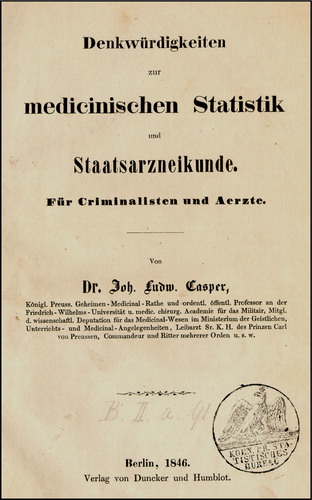
FIGURE 46 Tables from Casper's book, Denkwürdigkeiten zur medicinischen Statistik und Staatsarzneikunde, on the time of day in the ocurrence of death from various causes in Berlin (Casper, Citation1846).

FIGURE 47 Table from Casper's book, Denkwürdigkeiten zur medicinischen Statistik und Staatsarzneikunde, on the time of day of girl's and boy's birth in Berlin (Casper, Citation1846).
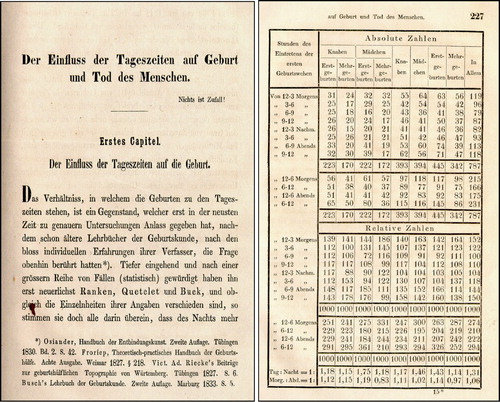
The impact of time of the year on the number of births and deaths is well known, as comprehensively reviewed by Smolensky (1972). presents the seasonal pattern of births and deaths for the author's family ancestors based on records extending from 1450 to 2008. In spite of the fact that the “natural conditions” of environmental light have greatly changed as a result of the invention of electric lighting and widespread use of contraceptive methods within the last century, there is, nevertheless, strong evidence for seasonal patterning of both birth and death.
FIGURE 48 Month of birth and month of death of members of the author's family based on data available from 1450–2008. Data were assembled by use of MacFamilyTree (unpublished, the author's own family; Lemmer, Citation2009).

It is obvious that both the beginning—represented by the time of birth—as well as its termination—documented by the time of death—of life do not occur at random times, but display significant daily and seasonal variation.
CONCLUSIONS
Though there are very early observations on temporal (e.g., 24 h and seasonal) variation in physiological and pathophysiological functions, such as on bronchial asthma by Caelius Aurelianus in the 5th century (Aurelianus, Citation1722), whose work was based on reports of Soranus from Ephesus who lived in the 2nd century, more detailed and more scientific reports were published beginning in the 17th century. It was the aim of this review to bring these early reports to the attention of both young and seasoned researchers in the field of chronobiology and chronopharmacology.
In this review, the author has referenced ancient books that he collected over time and are now a part of his personal library. The major intent of this review has been to demonstrate that chronobiology and chronopharmacology are not only modern branches of science, but that they have prominent roots in the past. From the number of books published since the 17th century, it is obvious that the mind and mental atmosphere during the Age of Enlightenment greatly stimulated physicians and other curious-minded individuals to observe and study in detail many diverse phenomena of life in plants, animals, and man. Sanctorius Sanctorius is regarded as the first physiologist who quantified his observations through performing experiments to measure respiration and weight. We have to take into consideration that the modern science of chronobiology stands on the shoulders of the wonderful observations and explanations of our scientific forefathers. As scientists, we should be modest and appreciate what has been discovered and presented in the last centuries. It is remarkable how many of the early observations and discoveries, especially relating to the symptoms of disease and invention of diagnostic devices—as mentioned in the paragraphs at the end of each of the sections—have been incorporated into clinical medicine and/or further developed in modern times. It is therefore concievable to state that physicians and scientists during the Age of Enlightenment paved the way to modern medicine, and, in particular, modern medical chronobiology and chronopharmacology.
Another point of this review has been to underline that a “modern” kind of publication politics, which insists on only English references in English-language journals—as exemplified by the Nature Publishing Group (Lemmer & Middeke, Citation2008)—is neither correct nor adequate for a scientific journal. This policy not only neglects scientific highlights of the past but other important contributions found in publications by scientists produced in other languages. It is the hope of the author that the reader will enjoy the richness of ancient reports that continue to contribute to our present knowledge of biological rhythms and the underlying research.
ACKNOWLEDGMENT
I highly appriciate the reviewers' excellent comments and pointing to additional references. This review is dedicated to my colleague and friend Alain Reinberg who shares with me the passion on history.
REFERENCES
- Aurelianus C. (1722). De morbis acutis & chronicis. J.C. Amman, recensuit, emaculavit, notulasque adjecit. Editio nova, Amsterdam, Wetsten, Amsterdam, pp. 429, 527.
- Autenrieth JH. (1801). Handbuch der empirischen Physiologie. Teil 1. Jacob Friedrich Heerbrandt, Tübingen.
- Autenrieth JH. (1802). Handbuch der empirischen Physiologie. Teil 3. Jakob Friedrich Heerbrandt, Tübingen.
- Barthez PJ. (1806). Noveaux éléments de la science de l'homme. Paris: Goujon et Brunot, pp. 147, 241.
- Bordenave M. (1787). Essai sur la Physiologie, ou Physique du Corps humain. Quatrième Édition, Tome premier at tome second, Méquignon l'aîné, Libraire, Paris, pp. 162–163.
- Brunner M, Simons MJ, Merrow M. (2008). Lego clocks: Building a clock from parts. Genes Dev. 22:1422–1426.
- Buchheim R. (1853–1856). Lehrbuch der Arzneimittellehre. Leopold Voss, Leipzig, p. 527.
- Casper JL. (1846). Denkwürdigkeiten zur medizinischen Statistik und Staatsarzneikunde. Duncker und Humblot, Berlin, pp. 217–248.
- Coste M. (1767). Traité des Maladies du Poumon. Paris: Herissant fils, pp. 43, 44, 50.
- Coste M. (1768). Traité-Pratique de la Goutte. Paris: Herissant fils.
- Cumming BG, Wagner E. (1968). Rhythmic processes in plants. Annu. Rev. Plant Physiol.. 19:381–416.
- Dardente H, Cermakian N. (2007). Molecular circadian rhythms in central and peripheral clocks in mammals. Chronobiol. Int. 24:195–213.
- Davy J. (1845). On the temperature of man. Philosophical Trans. Royal Soc. London. 135:319–333.
- de Bordeu T. (1756). Recherches sur le pouls. Paris: de Bure l'ainé, p.471.
- Dunlap JC, Loros JJ, DeCoursey PJ.( eds.) (2004). Chronobiology—biological timekeeping.Sunderland, Mass., USA: Sinauer Ass.
- Elsner CF. (1782). Beyträge zur Fieber-Lehre. Königsberg: Wagner und Denzel, pp. 28–29.
- Expert-Panel-Report. (2007). 3: Guidelines for the Diagnosis and Management of Asthma. Available at: http://www.nhlbi.nih.gov/guidelines/asthma/index.htm (accessed July 2009).
- Falconer W. (1797). Beobachtungen über den Puls. Leipzig: Heinsius, J. S., p. 24.
- Floyer J. (1698). A treatise of the Asthma. London: R. Wilkins & W. Innis.
- Floyer J. (1707–1710). The physician's pulse-watch; or an essay to explain the old art of feeling the pulse and to improve it by the help of a pulse-watch. Smith, S. Walford, B, London.
- Floyer J. (1761). Traité de l'asthme. Paris: PF Didot le jeune, pp. 20, 121.
- Gallerani M, Boari B, Smolensky MH, Salmi R, Fabbri D, Contato E, Manfredini R. (2007). Seasonal variation in occurrence of pulmonary embolism: Analysis of the database of the Emilia-Romagna region. Chronobiol. Int. 24:143–160.
- Gandini C. (1776). Gli elementi dell ARTE SFIGMICA. Napoli: Gaetano Castellano.
- Geiger M. (1652). Microcosmus hypochondriacus sive de melancholia hypochondriaca tractatus. Monachii (München): Lucam Straub.
- Hales S. (1727). Vegetable staticks, or, An account of some statical experiments on the sap in vegetable: Being an essay towards a natural history of vegetation. London: W. and J. Innys.
- Hales S. (1733). An account of some hydraulic and hydrostatical experiments made on the blood and blood vessels of animals. London: W. Innys & R. ManbyII.
- Hales S. (1748a). Statick der Gewächse oder angestellte Versuche mit dem Saft in Pflanzen und ihren Wachstum. Halle: Rengersche Buchhandlung.
- Hales S. (1748b). Statick des Geblüts. Halle: Rengerische Buchhandlung.
- Hales S. (1748c). Statick des Geblüts, bestehend in neuen Erfahrungen an lebendigen Thieren. Halle: Rengersche Buchhandlung.
- Hales S. (1779). Le statique des végétaux, et l'analyse de l'air. Paris: De Monsieur.
- Hales S. (1780). Haemastatique ou le statique des animaux. Paris: De Monsieur.
- Hastings MH, Maywood ES, Reddy AB. (2008). Two decades of circadian time. J. Neuroendocrinol. 20:812–819.
- Heberden W. (1772). Some account of a disorder of the breast. Medical transactions. London: Royal College Physicians, pp. 59–67.
- Hellwig C von. (Kräutermann V. Pseudonym). (1738). Curieuser und vernünftiger Urin-Artzt, welcher eines Theils lehret und zeiget, wie man aus dem Urin nicht allein die meisten und vornehmsten Kranckheiten … erkennen, .. Anderen Theils, wie man auch aus dem Puls den Zustand des Geblüts, die Stärcke und Schwäche der Lebens-Geister, Ab- und Zunahme der Kranckheit ersehen., Beumelburg, J. J., Arnstadt, Leipzig, p. 134.
- Hensen H. (1900). Beiträge zur Physiologie und Pathologie des Blutdrucks. Dtsch. Arch. Klin. Med. 67:436–530.
- Hermida RC, Ayala DE, Portaluppi F. (2007). Circadian variation of blood pressure: The basis for the chronotherapy of hypertension. Adv. Drug Delivery Rev. 59:904–922.
- Hill L. (1898). On rest, sleep and work and the concomitant changes in the circulation of the blood. Lancet 1:282–285.
- Holmgren H, Möllerström J, Swensson A.( eds). (1953). Verhandlungen der vierten Konferenz der Internationalen Gesellschaft für Biologische Rhythmus-Forschung, Hamburg 1949. Stockholm: Sveska Tryckeraktiebolaget.
- Hope J. (1833). Krankheiten des Herzens und der grossen Gefässe, German edition. Berlin: Theodor Christian Friedrich Enslin, p. 392
- Howell WHA. (1897). A contribution to the physiology of sleep, based upon plethysmographic experiments. J. Exp. Med. 2:313–345.
- Hufeland CW. (1797). Die Kunst das menschliche Leben zu verlängern. Jena: Akademische Buchhandlung, pp. 85–550–551.
- Jellinek S. (1900). Ueber den Blutdruck des gesunden Menschen. Z. Klin. Med. 39:447–472.
- Katsch G, Pansdorf H. (1922). Die Schlafbewegung des Blutdrucks. Münch. Med. Wochenschr. 69:1715–1718.
- Knox R. (1815). On the relation subsisting between the time of day, and various functions of the human body; and on the manner in which the pulsation of the heart and arteries are affected by muscular exertion. Edinburgh Med. Surg. J. 11:52–65.
- Labrecque G, Bureau JP, Reinberg AE. (1995). Biological rhythms in the inflammatory response and in the effects of non-steroidal anti-inflammatory drugs. Pharmacol. Ther. 66:285–300.
- Le Cat CN. (1767). Traité des sensations et passions en général et des sens en paticulier, ouvrage divisé en deux parties. Paris: Vallat-La-Chapelle, p. 286
- Lee H-C, Hu C-J, Chen C-S, Lin H-C. (2008). Seasonal variation in ischemic stroke incidence and association with climate: A six-year population-based study. Chronobiol. Int. 25:938–949.
- Leibowitz D, Planer D, Weiss T, Rott D. (2007). Seasonal variation in myocardial infarction is limited to patients with ST-elevations on admission. Chronobiol. Int. 24:1241–1247.
- Lemmer BLemmer B. (1989). Temporal aspects of the effects of cardiovascular active drugs in humans. Chronopharmacology—cellular and biochemical interactions. New York, Basel: Marcel Dekker, Inc, pp. 525–541.
- Lemmer B. (1991). The cardiovascular system and daily variation in response to antihypertensive and antianginal drugs: recent advances. Pharmacol. Ther. 51:269–274.
- Lemmer B. (1995). White coat hypertension: Described more than 250 years ago. Am. J. Hypertens. 8:437–438.
- Lemmer BWhite WB. (2001). Cardiovascular chronobiology and chronopharmacology: Importance of timing of dosing. Cardiovascular chronobiology and variability in clinical research and clinical practice. Totowa, NJ: Humana Press, pp. 255–272.
- Lemmer B. (2004a). Chronopharmakologie. Stuttgart: Wissenschaftliche Verlagsgesellschaft.
- Lemmer B. (2004b). Circadiane rhythmen und klinische pharmakologie. Internist. 45:1006–1020.
- Lemmer B. (2006). The importance of circadian rhythms on drug response in hypertension and coronary heart disease—from mice and man. Pharmacol. Ther. 111:629–651.
- Lemmer BWhite WB. (2007a). Chronobiology and chronopharmacology of hypertension. Clinical hypertension and vascular disease: Blood pressure monitoring in cardiovascular medicine and therapeutics. Totowa, NJ: Humana Press, pp. 413–435.
- Lemmer B. (2007b). Hypertension: Do we need to consider the biological clock in drug dosing?. Expert. Rev. Cardiovasc. Ther. 5:375–379.
- Lemmer B. (2009). Seasonal variation in the number of births and in mortality in one family from 1450–2008, unpublished.
- Lemmer B, Middeke M. (2008). Geschichte einer wissenschaftlichen Publikation—nur noch englische Zitate erwünscht [History of a scientific publication—only English references, please]. Dtsch. Med. Wochenschr. 133:2699
- Lemmer B, Portaluppi FRedfern PH, Lemmer B. (1997). Chronopharmacology of cardiovascular diseases. Physiology and pharmacology of biological rhythms. Heidelberg, Berlin: Springer-Verlag, pp. 251–297.
- Levi F, Schibler U. (2007). Circadian rhythms: Mechanisms and therapeutic implications. Annu. Rev. Pharmacol. Toxicol.. 47:593–628.
- Lewy AJ, Lefler BJ, Emens JS, Bauer VK. (2006). The circadian basis of winter depression. Proc. Natl. Acad. Sci. USA. 103:7414–7419.
- Marx H. (1946). Zur Klinik des Hypophysenzwischenhirnsystems. 2. Mitteilung “Hypophysäre Insuffizienz” bei Lichtmangel. Klin. Wochenschr. 24/25:18–21.
- Medicus FC. (1764). Geschichte Periode haltender Krankheiten. Frankfurt, Leipzig: Macklot, G. L.
- Menaker M. (2007). Circadian clocks: 50 years on. Cold Spring Harb. Symp. Quant. Biol. 72:655–659.
- Menzel W, Möllerström J, Petren T. ( eds). (1955). Verhandlungen der vierten Konferenz der Internationalen Gesellschaft für Biologische Rhythmus-Forschung, Basel 1953. Stockhom: AB Tryckmans.
- Middeke M, Lemmer B. (1996). Office hypertension: Abnormal blood pressure regulation and increased sympathetic activity compared with normotension. Blood Press. Monit.. 1:403–407.
- Müller CDie Messung des Blutdrucks am Schlafenden als klinische Methode—speciell bei der gutartigen (primären) Hypertonie und der Glomerulonephritis, I. Acta Med. Scand (1921a). 55:381–442.
- Müller CDie Messung des Blutdrucks am Schlafenden als klinische Methode—speciell bei der gutartigen (primären) Hypertonie und der Glomerulonephritis II. Acta Med. Scand (1921b). 55:443–485.
- Murat JA. (1806). De l'Influence de la Nuit sur les Maladies, ou Traité des Maladies nocturnes. Weissenbruch: Bruxelles, pp. 32, 70, 95, 102, 124, 127.
- Portaluppi F, Hermida RC. (2007). Circadian rhythms in cardiac arrhythmias and opportunities for their chronotherapy. Adv. Drug Deliv. Rev.. 59:940–951.
- Portaluppi F, Lemmer B. (2007). Chronobiology and chronotherapy of ischemic heart disease. Adv. Drug Deliv. Rev.. 59:952–965.
- Quantz JJ. (1752). Versuch einer Anweisung die Flöte traversiere zu spielen. Berlin: Voß, Johann Friedrich, pp. 57, 206, 261, 266–267.
- Quantz JJ. (1906). Versuch einer Anweisung die Flöte traversiere zu spielen. Leipzig: C.P. Kant.
- Redfern P, Lemmer B. (1997). Handbook of experimental pharmacology, vol. 125: Physiology and pharmacology of biological rhythms. Berlin: Springer.
- Reil JC. (1796). Von der Lebenskraft. Arch. Physiol.. 1:8–162.
- Reinberg A. (1998). Le temps humain et les rythmes biologiques. Paris: Edition Rocher.
- Reinberg A, Halberg F. (1971). Circadian chronopharmacology. Annu. Rev. Pharmacol.. 11:455–492.
- Reinberg A, Smolensky MH. (1983). Biological rhythms and medicine. Heidelberg: Springer Verlag.
- Reinberg AE, Lewy H, Smolensky M. (2001). The birth of chronobiology: Julien Joseph Virey 1814. Chronobiol. Int. 18:173–186.
- Riva-Rocci S. (1896). Un nuovo sfigmomanometro. Gazz. Med. di Torino 47:981–996.
- Roenneberg T, Chua EJ, Bernardo R, Mendoza E. (2008). Modelling biological rhythms. Curr. Biol. 18:R826–R835.
- Sanctorius SDe inventione remediorum (1631a). Geneva: Petrum Aubertum.
- Sanctorius SMethodi vitandorum errorum omnium qui in arte Medica contingunt (1631b). Geneva: Petrum Aubertum.
- Sanctorius S. (1664). De statica medicina. Et de responsione ad statiomasticem ars. Adrian Vlaque, Den Hagae.
- Sanctorius S. (1753). Ars de statica medicina aphorismorum sectionibus septem comprehensa. Accessit statico-mastix sive staticae medicinae demolito autore Hippolyto Obicio. Cum Sanctorii responsione ad statico-masticem. Iuxta exemplar excusum Ferrariae. Hermannum Ovenium, Duisburgi ad Rhenum.
- Smolensky MH, Peppas NA. ( eds). (2007). Chronobiology, drug-delivery, and chronotherapeutics. Adv. Drug Deliv. Rev.. 59, 823–1069.
- Smolensky M, Halberg F, Sargent F. (1972). Chronobiology of the life sequence. In Itoh S, Ogata K, Yoshimura N. ( eds). Advances in climatic physiology. Tokyo: Igaku Shoin, pp. 281–318.
- Smolensky MH, Hermida RC, Portaluppi F, Haus E. (2007a). Twenty-four-hour pattern of angina pectoris, myocardial infarction, and sudden cardiac death: Potential role of blood pressure, heart rate and rate-pressure product circadian rhythms. Biol. Rhythm Res.38:205–216.
- Smolensky MH, Lemmer B, Reinberg AE. (2007b). Chronobiology and chronotherapy of allergic rhinitis and bronchial asthma. Adv. Drug Deliv. Rev.. 59:852–882.
- Sprengel K. (1807). Handbuch der Pathologie. Zweiter Theil. Leipzig: Schäferische Buchhandlung.
- Sprengel K. (1810). Handbuch der Pathologie. Dritter Theil. Leipzig: Schäferische Buchhandlung.
- Straub RH, Cutolo M. (2007). Circadian rhythms in rheumatoid arthritis: Implications for pathophysiology and therapeutic management. Arthritis Rheum. 56:399–408.
- Struthius J. (1602). Ars Sphymica.. Basel: Ludovici Königs.
- Sweeney BW. (1987). Rhythmic phenomena in plants. San Diego: Academic Press.
- Sydenham T. (1697). The Whole Works of the Excellent Practical Physician Dr. Thomas Sydenham. The second edition corrected from the original Latin by John Perchey. London: Richard Wellington, pp. 215–222, 452–453.
- Takahashi JS, Hong HK, Ko CH, McDearmon EL. (2008). The genetics of mammalian circadian order and disorder: Implications for physiology and disease. Nat. Rev. Genet. 9:764–775.
- Targiri J. (1698). Medicina compendaria. Lyon: Fredericum Haringius, p. 662
- Testa AJ. (1815). Über die Krankheiten des Herzens. Halle: Johann Jacob Gebauer, p. 35, 140, 152, 321.
- Trousseau A. (1868). Clinique médicale de l'Hotel-Dieu de Paris. Vol. 2. J.-B. Baillière et fils, Paris, pp. 439–479.
- Vasco CP. (1616). Exercitationes medicinales ad omnes thoracis affectus, decem tractatibus absoluta. Raymon Colomerius (Raymundum Colomerium, Regis & Academiae Tolosanae), Toulouse, pp. 253–254.
- Virey JJ. (1814). Éphémerides de la vie humaine, ou recherches sur la révolution journalière, et la périodicité de ses phénomènes dans la santé et les maladies. Didot Jeune, Paris, Université Paris, pp. 6–40.
- von Basch S. (1881). Ueber die Messung des Blutdrucks am Menschen. Z. Klin. Med. 2:79–96.
- Weiss H. (1900). Blutdruckmessungen mit Gärtner's Tonometer. Münch Med. Wochenschr. 47:69–71 118–121.
- Weysse AW, Lutz BR. (1915). Diurnal variations in arterial blood pressure. Am. J. Physiol.. 37:330–347.
- Wilhelm GT. (1806a). Unterhaltungen über den Menschen: Dritter und letzter Band: Von dem Körper und seinen Theilen und Functionen insbesondere. Augsburg: Martin Engelbrechtsche Kunsthandlung, p. 181, 351–186.
- Wilhelm GT. (1806b). Von dem Körper und seinen Theilen und Functionen insbesondere. Augsburg: Martin Engelbrechtsche Kunsthandlung.
- Wirsung C. (1568). Arzney Buch. Faksimile-Nachdruck der Erstausgabe von 1568, Verlag Ernst Bloch, Rümikon, Schweiz, 1995. Exemplar-Nr. 28, Johannem Mayer, Heidelberg, pp. 201–202, 253–254.
- Wirz-Justice A. (2008). Diurnal variation of depressive symptoms. Dialogues Clin. Neurosci.. 10:337–343.
- Wunderlich CA. (1868). Das Verhalten der Eigenwärme in Krankheiten. Leipzig: Otto Wigand.
- Zadek J. (1881). Die Messung des Blutdrucks des Menschen mittels des Basch'schen Apparates. Z. Klin. Med. 2:509–551.
- Zimmermann JG. (1793). Von der Erfahrung in der Arzneykunst. Agram: Edlen von Trattnern, J. T, pp. 233–234 247.
- Zuther P, Lemmer B. (2004). Chronos-Fit. Available at: http://www.ma.uni-heidelberg.de/inst/phar/forschungLemmer.html.
